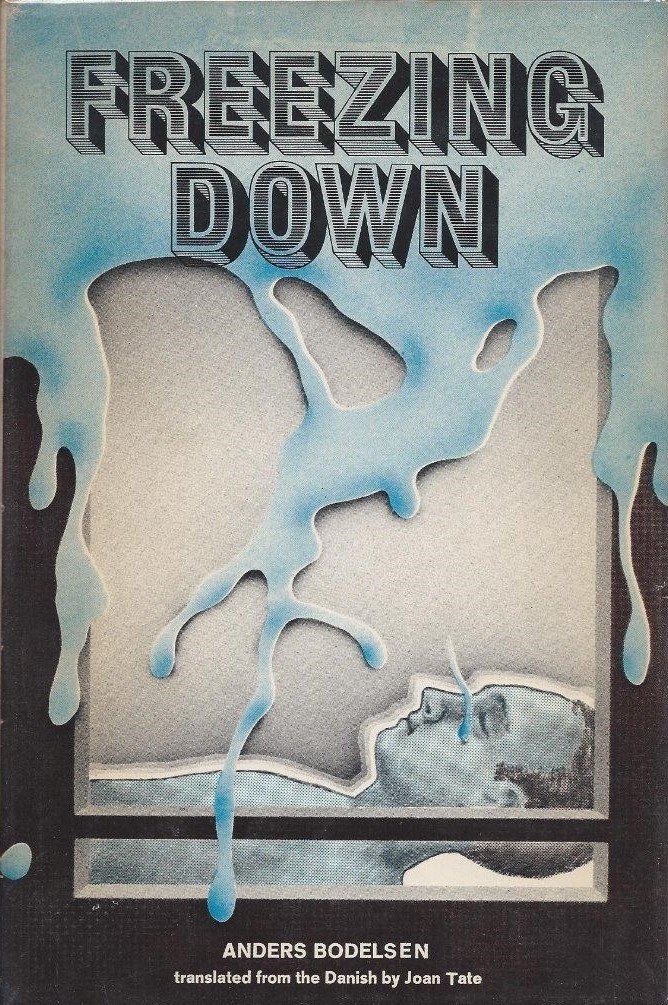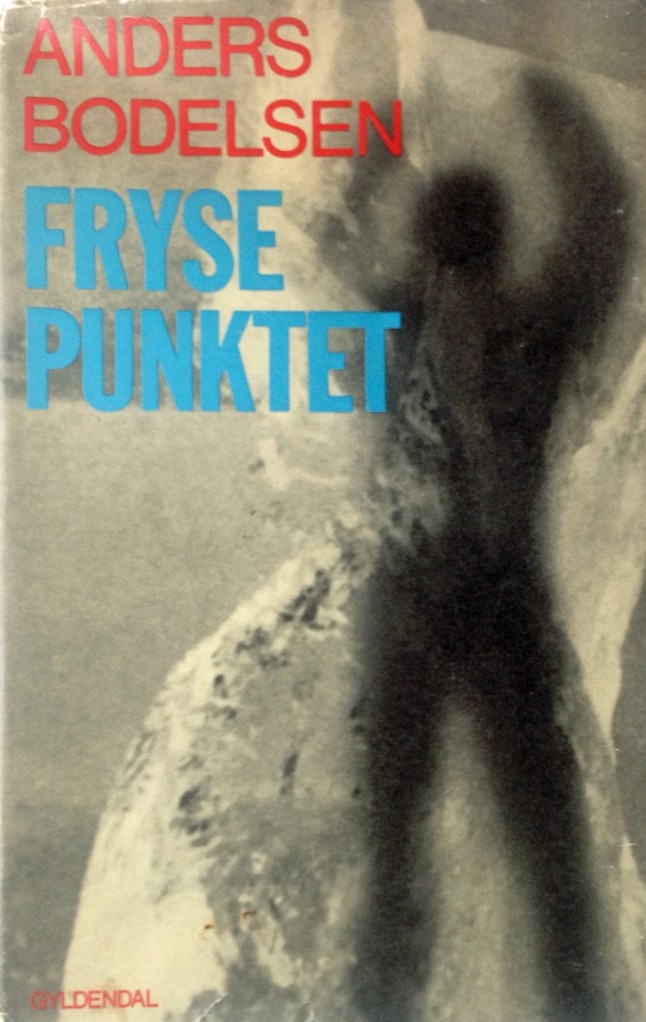(Cloud Studio’s cover for the 1971 edition)
4.5/5 (Very Good)
Anders Bodelsen’s Freezing Down (1969, trans. 1971) is a harrowing collision of SF tropes and the emotional landscape of Scandinavian noir. Bodelsen, “primarily associated with 1960s New-Realism in Danish literature,” might be best known to English-speaking audiences for writing the source material for the 1978 heist film The Silent Partner, starring Christopher Plummer and Elliott Gould.
Freezing Down, Bodelsen’s lone SF work, is an icy and complex (despite its brief length) speculation on the promise of immortality.
A forgotten masterpiece.
Brief Analysis/Summary
1973. Bruno is an editor. He’s constantly on the phone with his writers plying them with plots and themes, “he was the man with the most ideas” (5). He doesn’t write himself, but he has grand plans! He’s single. One day he meets a dancer named Jenny, who seems like one of his characters, distant, remote…. Ostensibly to gather ideas, he arrives at her house and discusses her goals, her desires, her drive for her art. While Bruno never implements his plans, Jenny gives all for hers. There’s a connection but Bruno cannot communicate his secret–his incurable illness and decision to wake up in another time through the process of “freezing down.”
1995. Bruno, after doctors discover a cure for his illness, emerges from his icy interlude, without his own kidneys. A new world order promises greatness, but beneath the veneer of immortality and progress, the limbs propping up humankind have rotted. Those that want immortality are forced to work to pay for their treatments. Those who decide to live out their natural lives, try whatever means possible to forget that death i.e. a preventable moment in life, is near. Not all are happy. Bruno observes agitators interrupting the infrequent flow of cars, only owned by doctors, outside the hospital. Bruno discovers a world where his talents seem useless, and Jenny, still alive but in a state of “freezing down,” has decades to wait until her own injuries can be cured. Bruno decides to re-enter his frozen state.
2022. The language has changed. The agitators grow in strength, but what they’re agitating for remains elusive. Connections are increasingly impossible to achieve—the anti-aging processes appear to introduce senility. Communication is fragmented and the events of the world outside of the hospital, a windowless environment of flickering lights, remains unknown: ‘Who ruled the world outside this building he was in? […] Did people read in this world?” (165). Bruno meets a thawed Jenny. Brunno tries to make connections. Jenny tries to dance: “Why does she keep falling?” (167). Bruno’s body deteriorates as restorative processes are interrupted by power cuts.
Freezing Down ends in a grotesque danse macabre of physical and intellectual decay. Immortality as an act of fragmentation….
Final Thoughts
Freezing Down is an unnerving exercise in physical and mental discomfort. A particular scene exemplifies my point. In 2022, the following tableau unfolds: Bruno, missing hair and fingernails, finally meets Jenny, recently thawed with a new spine installed. The hospital lights flicker in and out. A newly “young” Dr. Ackermann, who originally froze Bruno, periodically interrupts the emotion-drenched exchange, bewildered at the hospital’s flickering lights: “‘Don’t ask me […] No one tells me anything nowadays” (152). The poignant and aching moment is littered with Ackermann’s repetitive comments about Bruno’s missing body parts, and the candle in his pocket in case the lights go out… Ackermann confesses that “[He’s] long since given up trying to understand” (158).
Adding to the growing nightmare, Bodelsen deploys spatial constriction in each successive age. In 1973, Bruno moves in and out of the hospital if he needs to before the final countdown to his procedure. In 1995, only as his depression grows do the doctors move him to a new location as therapy. In 2022, the hospital no longer has windows, and the outside world is a great unknown.
Bruno’s increasingly restrictive perspective through which he views the world, is foreshadowed by the dominate image that begins and ends and is referenced throughout the text:
“[Bruno] wants to look at the thermometer outside the window, but he cannot because of the ice crystals. Still only half awake, he remembers how as a child he had put a coin on the radiator and then pressed it against the ice crystals to give himself a little hole he could peep through, out into a dark winter’s morning like this” (3).
And as time progresses, it becomes more and more difficult to see through the ice. The ice is no longer a barrier but a tomb. Bodelsen’s prose is characterized by an intensity made more and more unnerving as the ability to communicate and connect decays. Bodies might be resurrected in the semblance of earlier vitality but the future is not full of hope, the future is an alien landscape.
Find a copy.
(Uncredited cover for the 1969 Danish edition)
(Uncredited cover for the edition)
(Klaus Kammerichs and Heinz Edelmann’s cover for the 1971 German edition)
(Atelier Frank & Zaugg’s cover for the 1973 German edition)
(Foto Unit’s cover for the 1972 Belgian edition)
For more book reviews consult the INDEX






Fabulous, fabulous covers – though the first and last ones are my standout favourites:)
Yeah, they are definitely intriguing covers — and pick up the main theme of novel (as I spell out in the review).
Does the novel itself seem interesting?
Yes it does! Though I’m a bit wary of vintage sci fi – the worldbuilding, pacing and attitudes often jar with me.
Ah, well, you know, my entire site is vintage SF…. curious why you visit so frequently if that is the case!
Because I love the covers – having all the depth of a pavement puddle! And just because I’m wary doesn’t mean I’m not curious or willing to be informed…
I understand. I enjoy the covers — but prefer the texts!
This particular novel does not have any questionable content regarding attitudes, etc. It’s a fascinating book in every way — and, as a fan of Scandinavian noir TV and movies it’s fun seeing its intersection with SF.
$2 + shipping for hardback copies on Amazon. Grab one!
Hi
Wow what a take on cryogenics and immortality. It sounds pretty grueling.
I am torn between the cover for the Berkley and the 1972 Belgian edition.
Regards
Guy
It’s dark and stylish — with some literary complexity. I loved it! (as you could probably tell).
I think my favorite is the Berkley edition…. for some reason the 1st ed. hardbacks are FAR cheaper online so that’s what I ended up with.
Thanks, will try to hunt one down!
Found a Dutch edition, will go for that as it’s a translation anyhow. I also like the Dutch title a lot: “My love (girlfriend) lies deeply frozen”, it’s quite poetic in Dutch.
Does it have a different cover than the ones I posted? I suspect isfdb.org’s publication history for non-US editions is spotty at best.
I haven’t received it yet obviously, but essef.nl is trustworthy and their cover posting is the same. Great website, I guess you know it.
Or, is it the Belgian edition I posted (which is clearly in Dutch)?
I think there is no Belgian edition, Prisma, the publisher, is a Dutch company.
I’ll go ahead and change it — not sure where I saw that…. I assumed it was for the Dutch speaking area of Belgium.
The literary markets overlap to a big degree, although they have been growing apart since the beginning of the 90s. It’s safe to say however that back in the days these Prisma pockets were marketed and sold both in The Netherlands and Flanders.
Or actually, Prisma was a pocket series of Het Spectrum, a Dutch publishing company, which was sold to the Belgian publisher Lannoo in 2010.
Yet another book to add to the want list. The Berkeley International Science Fiction titles always look intriguing, but it’s hard to find a list of them. So far, I think I’ve only read Abe’s Inter Ice Age 4, but this series seems to have some real gems.
There are only a handful of others in the series (a few Strugatsky, a french novel, and maybe three or four others?).
The Internet Speculative Fiction Database has a list! (always the first place I check). it’s down at the moment else I’d provide a link.
Ah, never mind, it doesn’t have a clear list — you have to search through the Berkley Medallion publication series by year — for example, here 1972: http://www.isfdb.org/cgi-bin/publisheryear.cgi?245+1972+1
Yeah, I think that’s as far as I got also (there’s one more in the 1974 page). I also seem to remember seeing a French novel in the series, and there’s also an edition of Lem’s Solaris with the “rainbow” on the cover.
Just read this, and you’re kot wrong: a real lost classic.
Anyone looking to read it should be able to borrow it from the Open Library at the Internet Archive.
Or snatch a super cheap copy online! (it was $4 with shipping a while back).
Glad you enjoyed it.
I have just bought a hardback copy inspired by your review. My copy is the 1971 edition and is titled “Freezing Point” and published by Michael Joseph. It has a different cover from those above. I can email a photo of the dust jacket if you wish to include it.
PS Great website Joachim!
I hope you enjoy it!
You can link an equivalent cover here.
If you want to send an email, click the “About Me” for contact info.